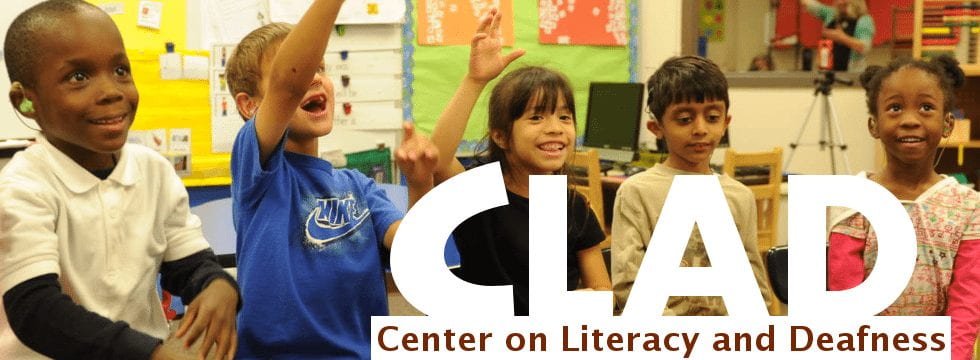Center on Literacy and Deafness was a Special Education Research and Development Center on Reading Instruction for Deaf and Hard of Hearing Students funded by the the Institute of Education Sciences in 2012 via Grant R24C120001.
Purpose: Poor literacy skills have been characteristic of the deaf population for decades. National data suggest that median literacy rates of deaf high school graduates have remained consistently around the fourth grade level since the beginning of the twentieth century. About one in five deaf students who graduate from high school have reading skills at or below the second grade level; about one in three deaf students who graduate from high school have reading skills between the second and fourth grade level. Compared to deaf students, hard of hearing students (i.e., those with mild to moderate hearing loss) fare better overall, but even mild hearing losses can create significant challenges for developing reading skills. Proficiency in reading is critical for furthering one’s education and achieving success in the workplace. Improving reading outcomes for students who are deaf or hard of hearing (DHH) requires substantial additional research, particularly research to identify, develop, and test instructional approaches, curricula, and other innovative education interventions designed to enhance the reading skills of students who are deaf or hard of hearing. The Center focused on a program of research to explore underlying factors related to literacy for young students who are deaf or hard of hearing (pre-kindergarten through Grade 3) and to develop innovative approaches to improving reading instruction for these students. The ultimate objective of the Center was to improve literacy skills for students in early elementary school to maximize the potential long-term impact of an early literacy skills intervention on literacy development and overall school performance.
Key Outcomes: The main findings of this study are as follows:
• DHH children’s reading ability depended on whether they were acquiring spoken or visual language. For DHH children who use spoken language, reading is related to spoken phonological awareness and spoken English. For children who use sign, reading is primarily related to fingerspelling phonological awareness and American Sign Language These qualitative differences indicate that signing DHH children need different instructional practices from those used with hearing children or DHH children learning only spoken language. (Lederberg, et al. 2019). Overall, children showed delays in language and reading compared to the test norms established for hearing children. In the area of language, vocabulary, though delayed, showed gains over the school year. Children showed the most severe delays in expressive English syntax. Sign-only and bimodal children showed gains in American Sign language (ASL) receptive syntax during the school year and by grade. In the area of reading, we found that reading declined from kindergarten to second grade. (Antia et al., 2020).
• Teachers’ instruction influenced the amount their DHH students learned during the school year. Students made greater language gains when their teachers expanded students’ language and gave simple definitions for novel words. Students’ reading gains were related to the the amount of time their teacher taught them how to decode printed words and the quality of that instruction, specifically the clarity of instruction and classroom management.
• Foundations for Literacy is a year long early literacy program specifically designed for DHH 3 to 6-year-olds. A national clustered randomized controlled study provided strong evidence that DHH children taught with Foundations enter elementary school with better foundational skills than DHH children receiving their typical instruction. It It is the only evidence-based early literacy intervention specifically developed for DHH children and is being used by teachers in thirty-five states across the country.
• Fingerspelling Our Way to Reading (FOWR) is a full year supplemental reading program for signing deaf children in kindergarten through second grade. The program was developed based on our initial observational research and has two components. . The first component involves using fingerspelling to teach children to read words. The second component explicitly teaches connections between American Sign Language and English. Our research suggests that FOWR shows promise for improving DHH children’s word reading, reading comprehension, and fingerspelling abilities. It is being used by teachers in 24 states across the United States.
• Explicit Contextualized Vocabulary Instruction provides sample lessons and instructions on how to use both explicit and in-context strategies to teach vocabulary. A series of single-case design studies showed that the children were able to learn new vocabulary and also use the new vocabulary in their spontaneous language. An extensive website that is open to the public has been developed to provide teachers with information necessary to develop vocabulary lesson plans and to use the strategies with DHH children.
• Syntax to Reading is an intervention designed to develop fluency in the expressive use of targeted syntactical structures. The intervention includes activities to call children’s attention to the targeted syntactical structures; interactive reading of stories that included the target structures; and practice activities that elicit the target structures in single sentences and in longer narratives. Our single subject research study showed that the children were able to use the target structures productively in connected language (manuscript forthcoming).
Visit the IES website
